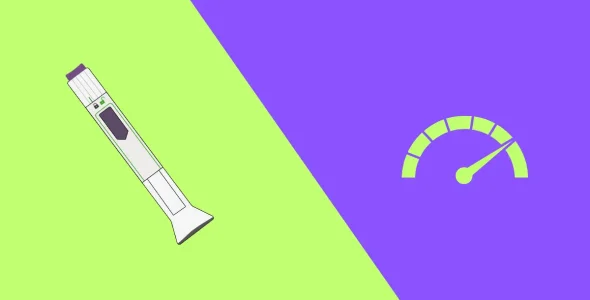Tirzepatide and pyridoxine: The compounded formula for weight loss with reduced side effects
The remarkable weight loss results from medications like tirzepatide are often accompanied by a challenging side effect: persistent nausea. But what if there was a way to target the benefits while proactively managing the discomfort?
Key highlights
- Tirzepatide (the active ingredient in brand names Zepbound and Mounjaro) is a dual receptor agonist of the GLP-1 and GIP receptors that promotes weight loss and blood sugar control when used alongside lifestyle changes.
- Vitamin B6 is added to the compounded tirzepatide due to its anti-nausea effect. It may also help reduce the intensity and severity of common gastrointestinal side effects such as nausea and vomiting that usually occur during treatment with tirzepatide.
- Combination of tirzepatide with vitamin B6 may help patients remain consistent with the therapy and improve long-term weight loss outcomes.
- Pyridoxine helps produce cellular energy (ATP) by breaking down carbohydrates, fats, and proteins, which reduces fatigue and supports overall well-being during weight loss
- This compounded formulation is not approved by the FDA for its safety, quality, and efficacy, and is prepared by licensed compounding pharmacies. Therefore, compounded drugs should be obtained from a licensed and reputable compounding pharmacy.
- You should not use this combination if you have pancreatitis, gallbladder issues, or a personal or family history of thyroid tumors, such as thyroid C-cell tumors and MEN2 syndrome.
Compounded tirzepatide with pyridoxine (vitamin B6) is a new formulation that is gaining popularity in wellness clinics. This combination contains the active ingredient and vitamin B6, which is well known for its nausea-fighting effect.
Zepbound (tirzepatide) is a dual GLP-1/GIP receptor agonist that provides more significant weight loss results (up to 20%) than single GLP-1 receptor agonists such as semaglutide (Wegovy) and liraglutide. However, the same hormonal action that makes tirzepatide most effective for weight loss often causes significant early side effects, such as nausea and vomiting, during the start of the treatment or during the escalation phase.
Compounding pharmacies offer tirzepatide with pyridoxine (vitamin B6) to potentially combat these common side effects. Pyridoxine is well known for its role in managing nausea, especially during pregnancy, and also provides an additional metabolic support to boost the effectiveness of tirzepatide.
In this article, we will break down everything you need to know about tirzepatide/pyridoxine, from the science behind it, how it works, and how to use it safely. This article will also explore the two scientifically theorized reasons for B6 (nausea control and metabolic support) and address the legal and regulatory status of the compounded formulation.
What is tirzepatide/pyridoxine?
Tirzepatide with pyridoxine (vitamin B6) is a custom-made compounded medication prepared by licensed compounding pharmacies that combines the drug tirzepatide with the vitamin Pyridoxine (B6). This compounded drug is not approved by the FDA and is not manufactured by Eli Lilly. This combination is used to potentially help manage tirzepatide-related common side effects such as vomiting and nausea.
What is tirzepatide?
Tirzepatide is the active ingredient in Mounjaro and Zepbound. Mounjaro is FDA-approved for managing blood sugar levels in adults with type 2 diabetes mellitus, and Zepbound is indicated for weight loss in patients with obesity and overweight with at least one weight-related health condition (high blood pressure or high cholesterol level) and mild to moderate obstructive sleep apnea.
Tirzepatide injection is a dual GLP-1 and GIP receptor agonist that mimics the action of two natural hormones, glucagon-like peptide-1 and glucose-dependent insulinotropic polypeptide, that regulate blood sugar levels and appetite (twincretin effect). The mechanism of action of tirzepatide is as follows:
- The medication mimics the activity of GLP-1 and GIP hormones to suppress appetite and reduce blood sugar levels.
- It decreases the peristaltic activity of the stomach that helps move food forward, resulting in decreased gastric emptying. Delayed stomach emptying promotes a feeling of fullness or satiety, which lowers food intake.
- Tirzepatide suppresses appetite by affecting the hunger control centre of the brain (or lateral hypothalamus).
- The medication increases insulin release and enhances its sensitivity to help the body use insulin more effectively and stabilize your blood sugar levels.
What is pyridoxine?
Pyridoxine is a form of Vitamin B6, which is an essential nutrient that helps the body use and metabolize proteins, fats, and carbohydrates more efficiently. It has a well-established FDA-recognized role in the prevention and treatment of nausea and vomiting in the following conditions:
- Pregnancy: Pyridoxine is a first-line therapy for patients with morning sickness during pregnancy and is part of the FDA-approved prescription combination doxylamine + pyridoxine.
- Post-surgery: Most people experience post-operative nausea and vomiting. Pyridoxine helps reduce post-operative nausea and vomiting.
These effects occur because Vitamin B6 (pyridoxine) helps regulate neurotransmitters in the brainstem, such as dopamine and serotonin, which play key roles in controlling nausea, vomiting, and gastrointestinal motility. Therefore, adding vitamin B6 directly to the Tirzepatide formulation may help mitigate the most common gastrointestinal side effects of the medication.
Why is pyridoxine combined with tirzepatide?
Tirzepatide is a dual GLP-1/GIP receptor agonist used for weight management and blood sugar control. This medication is effective but comes with common gastrointestinal side effects such as nausea, vomiting, diarrhea, and constipation. Pyridoxine is added to the formulation to counteract these side effects. Some of the possible combined benefits may include:
- Tirzepatide delays your stomach emptying and makes you feel full for longer by sending satiety signals to your brain, which results in appetite suppression and reduced cravings. Pyridoxine supports the synthesis of neurotransmitters (serotonin and dopamine), which help regulate your mood and appetite, enhancing the appetite-suppressing effects of tirzepatide.
- Pyridoxine (vitamin B6) is well known for its anti-nausea effects, particularly during pregnancy and in other nausea-associated conditions. Therefore, adding pyridoxine in the tirzepatide may address the common side effects associated with tirzepatide.
- According to various clinical trials, about 5% to 7% of people taking Zepbound discontinued treatment due to side effects, compared with about 3% in the placebo group. Most patients stopped the medication early in the treatment, mainly due to gastrointestinal side effects. The combination of pyridoxine with tirzepatide may help counteract these side effects, which may help patients adhere to the treatment for a longer duration to get long-term results.
Mitigating nausea and improving medication adherence
Tirzepatide helps suppress appetite by slowing gastric emptying. Strong appetite suppression is often linked with common gastrointestinal side effects such as nausea, vomiting, diarrhea, and stomach pain that usually occur during the start of the medication or during the titration phase when the dose is gradually increased as the body adjusts to changes.
Pyridoxine (vitamin B6) is added to compounded tirzepatide to potentially reduce the side effects of tirzepatide, such as nausea and vomiting. Pyridoxine is clinically approved for its role in suppressing nausea, specifically in pregnancy. In a randomized, double-blind, placebo-controlled study of 59 pregnant women, those receiving vitamin B6 (25 mg every 8 hours for 3 days) showed a significant reduction in nausea and vomiting compared to placebo. Among patients with severe nausea, the mean nausea score dropped by 4.3 points with vitamin B6 versus 1.8 points with placebo. After treatment, fewer women in the vitamin B6 group experienced vomiting (8 of 31) compared to placebo (15 of 28). These results show that vitamin B6 is effective as an antiemetic.
The main benefit of adding vitamin B6 to tirzepatide is that it may help improve tolerance to the medication. When patients experience fewer side effects, they are more likely to stay consistent with their treatment, which directly supports long-term adherence.
Metabolic support
Vitamin B6 acts as a cofactor in various enzymatic reactions and plays an essential role in energy metabolism. It helps break down proteins, carbohydrates, and fats, and converts food into cellular energy (ATP) to support normal metabolic functions.
This metabolic support may help reduce fatigue that usually occurs during weight loss treatment when patients are in a caloric deficit. Vitamin B6 helps the body maintain adequate energy levels for daily activities and physical exercise, and improves overall stamina and well-being by supporting energy metabolism.
A clinical trial involved 44 obese and overweight women aged 18–50, who received either 80 mg of pyridoxine hydrochloride (vitamin B6) or a placebo daily for eight weeks. Participants receiving vitamin B6 showed significant reductions in weight, body mass index (BMI), fat mass, waist circumference, and visceral adiposity index compared with baseline. Additionally, there was marked improvement in metabolic markers, including decreased fasting blood sugar, leptin, total cholesterol, LDL, and triglyceride levels. Adiponectin levels were significantly increased. These findings suggest that vitamin B6 supplementation may help reduce BMI, improve body composition, and promote metabolic health in obese and overweight women.
Tirzepatide/pyridoxine side effects
It is important to remember that tirzepatide is a prescription medication, not an over-the-counter medication. This medication should only be used when prescribed by a licensed healthcare provider after a medical evaluation to ensure safety and effectiveness.
Tirzepatide-related side effects
Tirzepatide is associated with the following common side effects.
- Nausea
- Vomiting
- Constipation
- Diarrhea
- Abdominal pain
- Stomach discomfort
These effects are usually dose-dependent and tend to improve as your body adjusts to the medication. Vitamin B6 is specifically added to help reduce these side effects.
Rare side effects of tirzepatide may include:
- Pancreatitis (inflammation of the pancreas)
- Gallbladder problems (gallstones and inflammation of the gallbladder)
- Severe abdominal pain or persistent vomiting
If you experience symptoms of pancreatitis or gallbladder issues, stop the medication and consult with your healthcare provider to seek medical advice.
Pyridoxine-related side effects
Pyridoxine is generally considered safe when used in low therapeutic doses, as in a compounded formulation. However, if it is used at very high doses over long periods, it can cause nerve damage (neuropathy). Therefore, the dose of pyridoxine (vitamin B6) in the compounded formulation should be within safe therapeutic ranges.
Warnings and contraindications
Compounded tirzepatide with pyridoxine may contain the same warnings and contraindications as brand-name tirzepatide (Mounjaro and Zepbound).
Compounded tirzepatide with vitamin B6 is a custom-made medication prepared by a licensed compounding pharmacy. Compounded drugs are not approved by the U.S Food and Drug Administration (FDA). This means that the safety, efficacy, and manufacturing quality of the medication are not reviewed by the FDA.
Compounded tirzepatide with pyridoxine is prepared by different compounding pharmacies. Therefore, the dosage, strength, and concentration may vary between pharmacies. This variability increases the risk of underdosing, which may reduce the effectiveness, or overdosing, which can cause severe side effects or toxicity.
The FDA has issued multiple warnings regarding the use of non-sterile ingredients and impurities in compounded medications such as tirzepatide. Contamination can occur from improper handling, inadequate sterilization, or the use of raw materials sourced from unverified suppliers. Therefore, you should only consider compounded tirzepatide/pyridoxine from licensed compounding pharmacies when prescribed by a qualified healthcare provider. Moreover, it is important to keep tirzepatide at room temperature (86°F/30 °C) to maintain its effectiveness.
Tirzepatide, along with pyridoxine, is not suitable for everyone. These medications should not be used in patients with a personal or family history of thyroid cancer (MTC) or multiple endocrine neoplasia syndrome type 2 (MEN 2). If you experience hoarseness of voice while taking tirzepatide, immediately consult your healthcare provider because it can be a sign of thyroid cancer. Do not take tirzepatide if you are breastfeeding, pregnant, or planning to become pregnant.
While tirzepatide with vitamin B6 may be effective for weight management and blood sugar control, it can cause some serious side effects that require immediate medical attention. These may include:
- Pancreatitis: Tirzepatide is not recommended in patients with a history of pancreatitis. During treatment, if you experience any signs and symptoms of pancreatitis, such as severe, persistent abdominal pain that may radiate towards the back, nausea, or vomiting, immediately consult with your doctor. This is an emergency condition and requires immediate discontinuation of the medication.
- Gallbladder issues: Tirzepatide can cause gallbladder issues, such as cholelithiasis and cholecystitis. Look for signs such as upper abdominal pain, stomach discomfort, fever, and jaundice (yellowing of the eyes and skin), which may indicate the presence of gallstones or gallbladder inflammation (cholecystitis), and consult your doctor.
- Kidney injury: Tirzepatide can cause severe diarrhea and vomiting, which can result in severe dehydration. Dehydration can lead to acute kidney injury in healthy individuals as well as in patients with preexisting chronic kidney disease. Therefore, it is important to maintain adequate hydration. If you experience severe vomiting or diarrhea, consult with your doctor for a possible dosage adjustment.
Tirzepatide may interact with other medications, affecting their absorption or increasing the risk of side effects. Before starting tirzepatide, inform your healthcare provider about all medications and supplements you are taking to ensure safe and effective treatment. Tirzapatide can interact with glucose-lowering medications and oral contraceptives.
When tirzepatide is used together with other diabetes medicines such as insulin or sulfonylureas, it can increase the risk of hypoglycemia (low blood sugar). Common symptoms of low blood sugar include shakiness, sweating, increased heart rate (tachycardia), blurred vision, and irritability. You should monitor your blood glucose levels regularly and consult with your healthcare provider regarding potential dose changes if you experience hypoglycemia.
Tirzepatide may reduce the effectiveness of oral birth control pills by slowing stomach emptying and potentially decreasing the absorption of the medication. Therefore, it is recommended to use an alternative or additional non-oral contraceptive method, such as condoms or other barrier methods, while taking tirzepatide.
If you miss a dose of tirzepatide, take the missed dose within 5 days or wait until your next scheduled injection day.
How to safely obtain tirzepatide/pyridoxine
Tirzepatide with pyridoxine is not approved by the FDA. Therefore, it is important to obtain these medications from legal and reputable compounded pharmacies. You can safely get the medication by following these steps:
- Online medical consultation: To book an online medical consultation, you will typically need to start by filling out a questionnaire. It will include questions about your medical conditions, current medications, serious allergic reactions, and treatment goals, so the telehealth provider can determine whether tirzepatide/pyridoxine is right for you.
- Provider review and prescription: A licensed healthcare professional will review your information and determine whether tirzepatide/pyridoxine is medically appropriate for you. If you are an eligible candidate for treatment, the healthcare provider will issue a prescription for the compounded formulation.
- Pharmacy dispensing and delivery: The prescription will be sent directly to a licensed compounding pharmacy, which prepares the medication. The pharmacy will then ship the medication directly to your home.
To ensure your safety, watch for these red flags:
- Any website offering tirzepatide or similar injectable medication without needing a valid prescription is usually illegal and unsafe.
- Avoid any service that does not offer a clear and direct consultation with a licensed medical professional. You should always have the chance to ask questions and review your health information before receiving a prescription
- Be cautious of the sites offering prices lower than the actual prices or making guaranteed weight loss promises.
- Do not use medication with “research purpose only” labels.
- Do not purchase if the ingredients of the medication are not mentioned on the labeling.
Frequently asked questions
Is compounded tirzepatide with B6 legal?
Yes, compounding tirzepatide with vitamin B6 is a regulated and legal practice because this combination is used to meet the patient’s specific needs (to help manage the side effects of the medication), which falls under the FDA’s compounding guidelines.
How much does it cost?
The cost of compounded tirzepatide with Vitamin B6 typically ranges from $350 to $650 per month, depending on the dosage and the compounding pharmacy.
Will my insurance cover it?
No, insurance does not cover compounded tirzepatide with vitamin B6. Compounded medications are typically not covered by insurance.
Is this the same as the “Mounjaro B6” or “Zepbound B6” I see online?
No. The terms Mounjaro with B6 and Zepbound with B6 may be incorrectly used to describe the compounded formula of tirzepatide and pyridoxine (B6), which helps reduce nausea and improve tolerance. However, there is no “Mounjaro B6” or “Zepbound B6” available.
How is it dosed and administered?
Tirzepatide with vitamin B6 is administered as a once-weekly subcutaneous (under the skin) injection in the abdomen, thighs, or upper arm. However, the injection site should be rotated each week to prevent irritation, lump formation, and tissue damage. The medication is started at a low dose, which is gradually increased (titrated) over several weeks to reduce the risk of common gastrointestinal side effects. The exact dosing schedule and strength are determined by your healthcare provider according to your body’s needs and response.
Conclusion: Is tirzepatide/pyridoxine right for you?
Tirzepatide with pyridoxine is a compounded formula designed to make medical weight loss more comfortable and effective by combining the weight-lowering effects of tirzepatide with the metabolic and anti-nausea support of vitamin B6. This combination may be suitable for individuals who want to lose weight with tirzepatide while proactively reducing its most common side effects, such as nausea and vomiting. Additionally, this combination may improve treatment adherence and help you stay consistent with your treatment to achieve long-term results.
A partnership with a qualified healthcare provider or a trusted telehealth service can help you navigate your weight loss journey safely. Avoid self-sourcing or using unverified products, as compounded medications vary in quality and potency. Always obtain tirzepatide with pyridoxine through a licensed and reputable provider.
Your path to lasting health starts with informed choices. Consult your healthcare provider to discuss your treatment goals, the pros and cons of this combination, and whether it is clinically appropriate for you. After starting the treatment, have regular follow-ups with your doctor for continuous care and monitoring.






